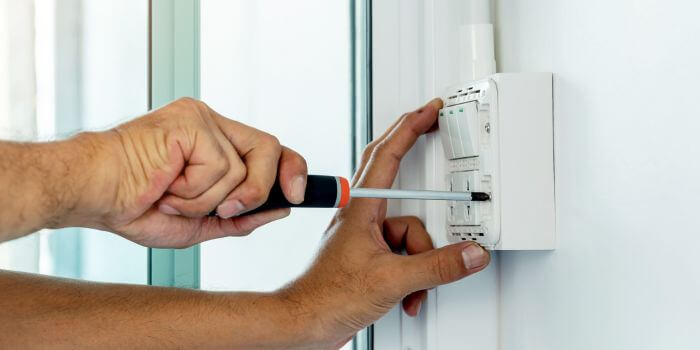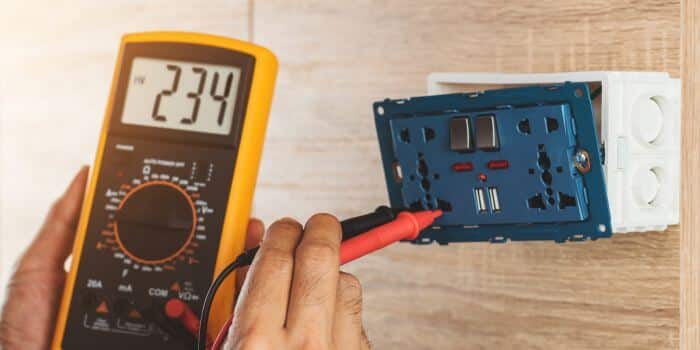Table of Contents
Excess electrical flow
Plugging in too many appliances at once into your electrical outlet can cause an excessive flow of current in your circuits.
Luckily, if too much electrical flow is detected, your circuit breaker will trip the breakers to prevent damage to any appliance connected to the outlets.
While circuit breakers are quite reliable in managing current flow, you should be wary of electrical overloads.
Some common signs of excess electrical flow in your circuits include flickering lights, odd noises, burning odors, etc. We will talk about these signs in detail in the sections below.
What Causes Electrical Circuit Overloads?
The basic principle is – electrical circuits are designed to carry a certain amount of current. However, the circuit will overload if the electric flow exceeds its capacity.
This is usually caused by connecting too many power-hungry appliances to your electrical outlets.
Most of the time, you can rely on your circuit breaker to resolve the issue for you. But if your circuit breaker or ground wires become faulty, you could face serious issues.
That is why you must ensure that your circuit breaker and ground wires are in good condition.
You should also know how to test the ground with a multimeter to make sure it is in proper working condition in case your circuit breaker fails.

5 Signs That Show Excess Electrical Flow in Your Circuits
In this section, we will talk about the signs of an overloaded circuit. All of the signs are pretty simple and easy to notice. If you detect any of these signs in your home circuit or car, immediately take proper action.
1. Flickering Lights:
Your lights may start flickering if excess electricity is running through the circuit. Sometimes your lights will start getting dimmer. It’s the most common sign that your circuit is starting to overheat.
If the flickering continues, it might cause permanent damage to the lights. The best course of action would be to turn off the lights and check your circuit board.
Give it some time and check if the problem persists. In case it doesn’t go away, you will need to contact a trained electrician.
2. Strange Noises:
Hearing buzzing sounds is another common symptom of excessive electrical flow. If you notice that your vehicle or house makes odd sounds when you turn on any lights or appliances, your circuit is likely to be overloaded.
The strange noise also indicates that the wiring is becoming overheated. And if the noise starts to increase, it is a sign that your wiring is in trouble.
At some point, the wire will just burn out, breaking the whole circuit. So, don’t ignore these noises if you hear them.
3. Burning Odors From Outlets or Switches:
If you smell a burning odor in addition to strange noises, be very careful with what you do next. Most of the time, the burning smell will come from directly beneath the switches.
The switches may also develop burned marks on them. Do not touch them directly if that is the case, as there is a high chance that an electric fire may have erupted in your outlet.
However, this issue is not only limited to switches. Electric plugs may also emit burning odors if the wiring becomes too hot.
This is a clear sign that you should turn off the power. But if the issue persists even after several minutes, there is a chance that an electric fire may have started. Call for help and evacuate the vicinity immediately.
4. Switch Covers Become Too Hot:
You may notice that your switches become warmer the longer you keep them on. This is another sign that shows excess electrical flow.
In some cases, the switch may become impossible to touch due to the heat. The high temperature can easily melt or burn out switches. It’s best to leave them alone in this case.
You can wait for a bit to see if the heat persists. The warm switches also pose a risk of you getting shocked.
There is also a chance of sparks flying out, so don’t keep any flammable objects nearby. Hence, you should contact professional electricians and replace the switch.
5. Mild Electric Shocks:
Have you ever tried turning on an appliance and received a shock? This indicates that excess electricity has built up on the appliance.
So, as soon as you touch the appliance, especially ones made out of metal, the electricity is discharged through your body.
This issue can be caused by two reasons: either the appliance is faulty, or your circuit is overloaded. Try changing out the appliance and see if the problem is resolved.
If not, then it is likely that your circuit has started developing issues. A simple fix to this is to ground these appliances before using them.

Solution To Overloaded Circuits
The first thing you should do for overloaded circuits is unplug some appliances. Instead, plug them into other low-demand circuits.
This will reduce the pressure on the overloaded circuit, and with time, it should go back to normal.
Additionally, you should start using low-power bulbs like CFL. These bulbs do not put pressure on the circuit and prevent excessive electric flow.
Moreover, avoid plugging in and turning on too many electric appliances at once. Or you can install circuits with higher capacities.
And if you are in the market to buy a new home, make sure to conduct a proper building inspection to check if the circuits are working correctly.
Conclusion
Now that you know the signs that show excess electrical flow in your circuits, you can be more careful next time.
If you notice any of these symptoms, take immediate action, as the consequences can be lethal.
You can try a simple fix like unplugging your appliance, then waiting for a bit before plugging them back in.
You can also replace the appliance to see if the problem continues. If it does, then it’s best to consult with professional electricians.
FAQs
How to Prevent Overloaded Circuits?
You should always check the wiring of your house’s electric circuit. Moreover, you should avoid using power-hungry appliances. Instead, go for energy-efficient products as they are significantly less demanding. Also, don’t use all your appliances and electric tools simultaneously.
How to Fix an Overloaded Breaker?
The first step is to unplug all your running appliances from the circuit if you suspect an overload. Next, plug them into different circuits with a low electric flow. Also, you need to flip the circuit breaker or replace it for future safety.
How to Fix Circuit Overload?
Turn off or unplug the appliances which are running. If it does not fix the issue, then it’s better to talk with electricians. In some cases, replacing the entire circuit may be required if it becomes too degraded or old.
Also, Read
5 Essential Factors to Consider When Building A House
Creative Ways to Cover The Hairline Cracks in Your
Important Repair Works You Need to Do After Purchasing a Used Home
Cost-Effective Ways to Enhance The Durability of Your Wood Floor